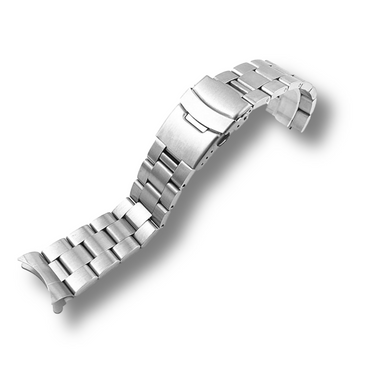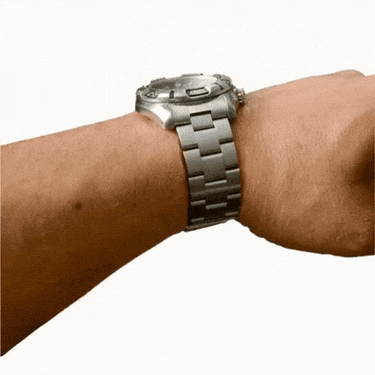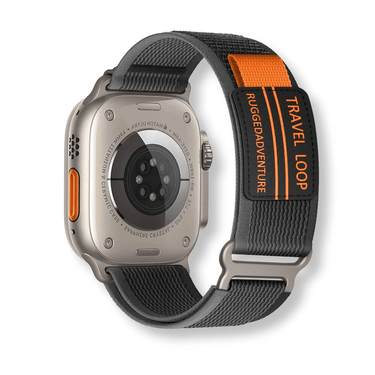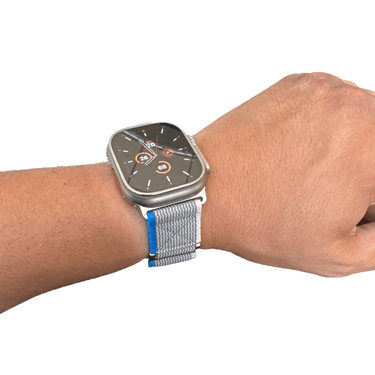As scuba diving enthusiasts, ensuring our safety should always be a top priority. One crucial accessory that can greatly enhance dive safety is a dive watchband with decompression tables. These watchbands have evolved over time to provide scuba divers with essential features, such as bezels and dials, that help track dive time, calculate no-decompression limits, and plan decompression stops.
At Watchband.direct, we understand the importance of dive safety, which is why we offer a wide range of dive watchbands with decompression tables for scuba divers to choose from. Our selection includes top-quality brands and designs that cater to divers of all levels and preferences.
Key Takeaways:
- Dive watchbands with decompression tables enhance dive safety for scuba divers.
- These watchbands include features such as bezels and dials for tracking dive time and planning decompression stops.
- Watchband.direct offers a wide selection of dive watchbands with decompression tables for divers to choose from.
- Choosing the right dive watchband is crucial for maximizing dive safety and preventing decompression illness.
- Investing in a dive watchband with decompression tables is an essential step for scuba divers looking to prioritize their safety.
Understanding Decompression and Dive Watch Markings
Decompression is a vital process for scuba divers to safely ascend to the surface after spending time at depths. As a diver descends, the increasing pressure causes compressed nitrogen to seep into their tissues. To prevent decompression illness, divers must make decompression stops at specific depths to allow the excess nitrogen to be released from their tissues.
Dive watch markings, including bezels and dials, play a crucial role in providing divers with important information to track their elapsed time, calculate no-decompression limits, and plan decompression stops. While these markings may seem complex and unfamiliar to divers, they are essential for ensuring safe diving practices.
To help divers visualize dive time and decompression stops, dive watches often feature rotating bezels, apertures showing decompression times, and multi-layer dials with decompression protocols. These specialized features allow divers to easily track their dive time and calculate their decompression stops, ultimately enhancing their dive safety.
By understanding decompression and dive watch markings, scuba divers can make informed decisions during their dives and ensure their safety during ascent. With the right equipment and knowledge, divers can enjoy their underwater adventures while minimizing the risks associated with decompression illness.
Dive Watch Markings Overview
Table: Dive Watch Markings
| Markings | Description |
|---|---|
| Bezels | Rotating bezels allow divers to track dive time and calculate no-decompression limits by aligning the zero mark with the minute hand. |
| Dials | Apertures on the dials display decompression times, providing divers with essential information for planning decompression stops. |
| Multi-layer Dials | Dive watches with multi-layer dials feature decompression protocols, making it easier for divers to visualize their decompression plan. |
As illustrated in the table above, dive watch markings, including bezels, dials, and multi-layer dials, serve as valuable tools for scuba divers. By understanding and utilizing these markings, divers can enhance their dive safety and make informed decisions during their underwater journeys.
The Role of Dive Bezels and No-Decompression Bezels
Dive bezels and no-decompression bezels are essential components of dive watchbands with decompression tables. These bezels play a crucial role in helping scuba divers track their dive time, calculate no-decompression limits, and plan decompression stops. Dive bezels are designed to indicate the no-decompression limit for each depth, allowing divers to stay within the recommended limits and ensure their safety.
No-decompression bezels, like the one patented by Doxa in 1967, offer a more convenient solution by engraving the no-deco limits right on the outer ring. This eliminates the need for clunky tables and provides divers with a quick and easy way to track their dive time. Watch brands such as Eterna, Heuer, and Citizen have also adopted this bezel design, recognizing its usefulness in enhancing dive safety.
"Dive bezels are a simple yet effective tool for scuba divers to stay within recommended no-decompression limits and ensure a safe ascent."
It's important to note that while dive bezels and no-decompression bezels are valuable tools for recreational diving, they do not account for adjusted no-deco limits for multiple dives or deeper dives that require decompression. For these situations, divers may need to rely on more advanced dive computers and decompression planning software to calculate their decompression stops accurately.
The Role of Dive Bezels and No-Decompression Bezels
| Dive Watch Feature | Description |
|---|---|
| Dive Bezels | Indicate the no-decompression limit for each depth |
| No-Decompression Bezels | Engraved with no-deco limits for easy tracking of dive time |
By understanding the role of dive bezels and no-decompression bezels and incorporating them into their diving gear, scuba divers can enhance their dive safety and make the most of their underwater adventures.
The Need for Decompression in Advanced Diving
Advanced diving, also known as technical diving, involves going beyond the no-decompression limits and requires decompression stops during ascent. Unlike recreational diving, there is no direct path to the surface for these divers, and time becomes a crucial factor in their safety. Decompression in advanced diving depends on factors such as time spent at various depths and the gases used. Each dive requires a calculated decompression plan to ensure the safe release of excess nitrogen from the diver's tissues. Dive watches with decompression tables, like the one created by Vulcain for Dr. Hannes Keller's record-breaking dive in 1962, play a vital role in assisting divers in calculating their decompression stops and ensuring a safe ascent.
During advanced dives, divers must carefully manage their ascent to avoid decompression sickness. This condition occurs when nitrogen bubbles form in the body's tissues due to rapid decompression. By following a carefully calculated decompression plan, divers can release the excess nitrogen in a controlled manner, reducing the risk of decompression sickness. Dive watches with decompression tables provide valuable information to help divers monitor their dive time, track no-decompression limits, and plan their decompression stops accurately. These watches allow divers to make informed decisions during their ascent and ensure their safety in challenging diving conditions.
| Benefits of Dive Watches in Advanced Diving | Features |
|---|---|
| Accurate Timekeeping | Rotating dials and bezels with clearly marked minute intervals help divers track their dive time precisely, allowing for accurate calculations. |
| Decompression Tables | The inclusion of decompression tables on dive watches provides divers with critical information on no-decompression limits and recommended decompression stops, ensuring a safe ascent. |
| Multi-Gas Compatibility | Dive watches designed for advanced diving often allow divers to input multiple gas mixtures, accommodating the use of different gas blends at different depths for optimal decompression. |
By utilizing dive watches with decompression tables, advanced divers can improve their safety and reduce the risk of decompression sickness. These watches serve as valuable tools in calculating decompression stops and assist divers in making informed decisions during their ascent. As the field of advanced diving continues to evolve, dive watches with advanced features and enhanced decompression capabilities will play an increasingly important role in ensuring the safety and success of these challenging dives.
Dive Watch Features for Decompression Planning
Dive watches designed for decompression planning offer a range of features that aid scuba divers in tracking their dive time and planning their decompression stops. These features play a crucial role in enhancing dive safety and ensuring a safe ascent. Some of the key dive watch features for decompression planning include:
- Rotating Dials: Dive watches often come equipped with rotating dials that allow divers to align the minute hand with the elapsed time marker, making it easy to track their dive time.
- Apertures Showing Decompression Times: Some dive watches have apertures on the dial that display the recommended decompression times for specific depths. This provides divers with instant access to crucial information for planning their decompression stops.
- Multi-Layer Dials with Decompression Protocols: Advanced dive watches feature multi-layer dials that provide divers with detailed decompression protocols. These protocols guide divers on the recommended depths and durations for decompression stops, ensuring a safe ascent.
In addition to these features, dive watches also often have finely demarcated hashes on the bezels, which can serve as backup timers during decompression stops. These specialized dive watch features enable divers to stay within the recommended decompression limits, reducing the risk of decompression illness and enhancing their overall dive safety.
"A well-designed dive watch with features tailored for decompression planning can make a significant difference in a diver's safety," says Mark Johnson, a veteran scuba diver and dive instructor. "By providing divers with crucial information at a glance, these watches aid in proper timekeeping and help ensure a safe ascent."
When choosing a dive watch for decompression planning, it's important to consider the specific features that best suit your diving needs. Brands like Vulcain and Fortis offer dive watches that incorporate these features, providing divers with reliable and accurate timekeeping tools. By investing in a dive watch with decompression planning features, scuba divers can maximize their dive safety and enjoy peace of mind during their underwater adventures.
| Dive Watch Feature | Description |
|---|---|
| Rotating Dials | Dive watches often come equipped with rotating dials that allow divers to align the minute hand with the elapsed time marker, making it easy to track their dive time. |
| Apertures Showing Decompression Times | Some dive watches have apertures on the dial that display the recommended decompression times for specific depths. This provides divers with instant access to crucial information for planning their decompression stops. |
| Multi-Layer Dials with Decompression Protocols | Advanced dive watches feature multi-layer dials that provide divers with detailed decompression protocols. These protocols guide divers on the recommended depths and durations for decompression stops, ensuring a safe ascent. |
The Reality of Diving in Commercial Settings
In commercial diving settings, such as underwater inspections or construction, the need for dive watches is minimal. Commercial divers operate with surface-supplied gas and rely on the diving supervisor to plan their dives and calculate decompression stops. Dive watches, while still appreciated for their aesthetics, have little practical use in these settings. Whether it's the saturation divers working on a barge or commercial divers in industrial environments, their focus is on the task at hand rather than timekeeping. These divers seldom wear dive computers and trust the expertise of their supervisors for safe diving practices.
Unlike recreational divers who rely on dive watchbands with decompression tables to enhance dive safety, commercial divers operate in a controlled environment where dive planning and decompression are carefully monitored by professionals. The dive supervisor is responsible for creating a comprehensive dive plan that takes into account factors such as depth, time spent underwater, gas mixtures, and decompression requirements. With the supervisor's guidance, commercial divers can safely conduct their tasks without the need to constantly refer to dive watch markings or calculate their own decompression stops.
While dive watches may not be essential in commercial diving settings, they still hold value from a visual and sentimental standpoint. Many commercial divers appreciate the craftsmanship and history behind dive watches, making them a cherished accessory even if they don't serve a practical purpose underwater. Some divers may choose to wear dive watches as a mark of their profession or as a reminder of their love for the sport outside of commercial settings.
The Role of Experience and Expertise
In commercial diving settings, experience and expertise play a crucial role in ensuring dive safety. Commercial divers undergo extensive training and gain practical experience before entering the field. This training equips them with the knowledge and skills necessary to perform their tasks efficiently and safely. Additionally, commercial diving companies have rigorous safety protocols in place, ensuring that divers operate within established guidelines and procedures.
Overall, while dive watches may not have a functional role in commercial diving, they remain a symbol of the diving profession and hold sentimental value for many divers. In this specialized field, it is the experience, expertise, and guidance of the diving supervisor that ensures safe and successful dives.
Diving Training and the Role of Pool Sessions
Pool sessions are an integral part of diving training, providing both beginners and experienced divers with valuable opportunities to enhance their skills and knowledge. Whether you're taking your first plunge into the underwater world or looking to refine your techniques, pool sessions offer a controlled environment for learning and practice.
During pool sessions, beginners can familiarize themselves with the essential equipment and get comfortable with the basics of scuba diving. Under the guidance of experienced instructors, they can learn at their own pace, building confidence and developing essential skills like buoyancy control and mask clearing. Pool sessions also allow individuals to determine if diving is the right sport for them, without the added complexities of open water environments.
Experienced divers can also benefit from pool sessions. It's an opportunity to refresh their diving knowledge, practice advanced techniques, and stay engaged with the sport throughout the year. Pool sessions provide a convenient way to try out new equipment, fine-tune skills, and even simulate challenging scenarios. By utilizing pool sessions, seasoned divers can maintain their proficiency and readiness for future diving adventures.
Benefits of Pool Sessions in Diving Training:
- Safe and controlled environment for learning and practice
- Opportunity to familiarize beginners with scuba diving equipment
- Builds confidence and essential skills
- Allows experienced divers to refresh their knowledge and practice advanced techniques
- Serves as a platform to try out new equipment and simulate challenging scenarios
"Pool sessions provide a crucial foundation for divers, allowing them to develop the necessary skills and knowledge before venturing into open water. It's a supportive and controlled environment that instills confidence and sets the stage for safe and enjoyable diving experiences." - Dive Instructor
Pool sessions play a vital role in diving training, benefiting divers of all levels. Whether you're just starting or have years of experience, taking advantage of these sessions can enhance your skills, boost your confidence, and keep you connected to the amazing world of diving all year round.
| Benefits of Pool Sessions | Beginners | Experienced Divers |
|---|---|---|
| Safe and controlled environment | ✔️ | ✔️ |
| Familiarize with equipment | ✔️ | |
| Build confidence and skills | ✔️ | |
| Refresh knowledge and practice advanced techniques | ✔️ | |
| Try out new equipment and simulate challenging scenarios | ✔️ |
The Importance of Diving as a Year-Round Activity
Diving is a thrilling and exhilarating activity that allows individuals to explore the underwater world and witness the beauty of marine life. While many people associate diving with vacation time or warm weather destinations, it's essential to recognize the importance of making diving a year-round activity. By staying involved in diving throughout the year, divers can enhance their skills, stay connected to the diving community, and maximize their overall dive safety knowledge.
Engaging in pool sessions and training activities on a regular basis is an excellent way to make diving a year-round activity. Pool sessions offer a controlled and familiar environment for divers to practice their skills, try out new equipment, and refine their techniques. Whether you're a newly certified diver looking to gain confidence or a seasoned diver wanting to stay connected to the sport, pool sessions provide a convenient and accessible way to engage in diving on a consistent basis.
By participating in year-round diving activities, divers can also enhance their overall dive safety knowledge. Regular practice and training contribute to improved skills, which can be crucial in emergency situations. Additionally, staying involved in diving allows divers to stay up to date with the latest dive safety protocols, equipment advancements, and industry trends. This knowledge can help divers make informed decisions and ensure their safety during future dives.
Furthermore, making diving a year-round activity fosters a sense of camaraderie and connection within the diving community. Divers who engage in regular diving activities have the opportunity to meet and interact with fellow divers, share experiences, and learn from one another. This sense of community not only enhances the overall diving experience but also provides a support system that can be beneficial in times of need.
| Benefits of Year-Round Diving |
|---|
| Continual Skill Development: Regular diving practice improves skills and boosts confidence. |
| Enhanced Dive Safety Knowledge: Staying involved in diving allows divers to stay updated with dive safety protocols and industry trends. |
| Camaraderie and Connection: Engaging in regular diving activities fosters a sense of community among divers. |
Conclusion
Dive watchbands with decompression tables are a valuable tool for scuba divers to enhance dive safety. These watchbands provide divers with important information for tracking dive time, calculating no-decompression limits, and planning decompression stops. Through the use of bezels, dials, and other specialized features, divers can stay within recommended limits and reduce the risk of decompression illness.
While the practical use of dive watches may vary in different diving settings, their role in recreational diving and advanced diving cannot be overstated. They serve as a reliable and convenient way for divers to monitor their dive profiles and ensure safe ascents. By understanding the importance of dive watchbands with decompression tables and incorporating them into their diving gear, scuba divers can maximize their dive safety and enjoy a rewarding and safe diving experience.
Whether exploring colorful coral reefs or venturing into the depths of technical diving, dive watchbands with decompression tables provide divers with the critical information they need to make informed decisions. By investing in a high-quality dive watchband and familiarizing themselves with its features, divers can enhance their dive safety knowledge and confidently explore the wonders of the underwater world.
FAQ
Why are dive watchbands with decompression tables important for scuba divers?
Dive watchbands with decompression tables provide crucial information to enhance dive safety. They allow divers to track dive time, calculate no-decompression limits, and plan decompression stops, helping to prevent decompression illness and ensure safe diving practices.
What is decompression and why is it important in diving?
Decompression is the process divers go through to safely ascend to the surface after spending time at depths. It involves allowing excess nitrogen to be released from the body's tissues through decompression stops at specific depths. Decompression is important to prevent decompression illness and ensure a safe ascent.
What are the role of dive bezels and no-decompression bezels?
Dive bezels are used in conjunction with decompression tables to track dive time and ensure divers stay within recommended limits. No-decompression bezels, like the one patented by Doxa, engrave the no-deco limits on the outer ring for convenient tracking without the need for tables.
How is decompression handled in advanced diving?
Advanced diving, which goes beyond no-decompression limits, requires decompression stops during ascent. Dive watches with decompression tables help in calculating these stops based on factors such as time spent at various depths and gases used, ensuring a safe release of excess nitrogen.
What features do dive watches with decompression tables have for decompression planning?
Dive watches designed for decompression planning often have rotating dials, apertures showing decompression times, and multi-layer dials with decompression protocols. These features help divers track dive time, calculate decompression stops, and ensure safe ascent.
Are dive watches necessary in commercial diving settings?
In commercial diving settings, such as underwater inspections or construction, dive watches have minimal practical use. Commercial divers rely on diving supervisors to plan their dives and calculate decompression stops.
What is the role of pool sessions in diving training?
Pool sessions are important in diving training for beginners and experienced divers. They allow individuals to learn at their own pace, get comfortable with scuba diving, practice skills, familiarize themselves with new equipment, and stay involved in the sport throughout the year.
Why is it important to engage in diving as a year-round activity?
By engaging in pool sessions and training activities throughout the year, divers can make diving a year-round activity. This allows them to try out new gear, improve skills, stay connected to the diving community, enhance dive safety knowledge, and make the most of their diving experiences.
























